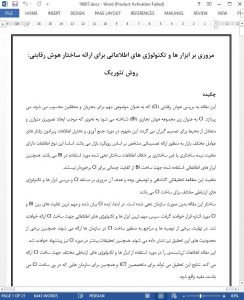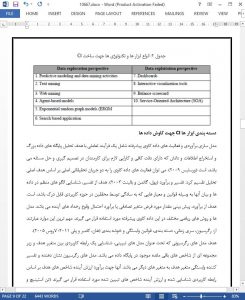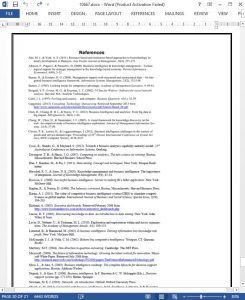Abstract
The paper refers to the Competitive Intelligence (CI) that is an important area of study for both practitioners and researches. CI is a subset of Business Intelligence (BI), providing balanced picture of the environment to the decision makers. It concerns the collecting and analyzing of the information about the behaviors of the various markets’ actors in order to make certain decisions based on market trends. This type of information is mainly semi-structured or unstructured nature- in contrast to the well-structured information used in BI. It turns out that many previous information tools used to build BI are insufficient and adequate for CI.
The research study is mainly exploratory and descriptive in nature, with the objective of providing an overview of the issue of CI and investigating the various information tools and technologies for CI building.
The structure of this paper is organized as follows. Firstly, the idea of CI is explained and the most important differences between BI and CI are highlighted. Next, the most significant information tools and technologies for building CI are preceded. Finally, some guidelines and recommendations are provided in order to build CI in organizations. Some limitations of this research are indicated as well. What is more, further studies on CI are outlined.
The paper provides some valuable information on using different information tools and technologies for CI building. The results of this study may be useful for ICT specialists, as well as for the organizations that plan to build CI.
Introduction The source of organization’s power has shifted from land, finance and capital to intangible resources (Herschel & Jones, 2005; McGonagle & Vella, 2002; Moss & Atre, 2003; Negash & Gray, 2008). The organizations are governed by information, knowledge, intelligence and wisdom (Liautaud & Hammond, 2002; Davenport & Harris, 2007; Wixom & Watson, 2010). The competitive advantage is based not only on products and finance, but also on intelligence, technology, software, education and culture.
Resource-based View (RBV), a well-known theory of strategy argues that organizations with valuable, rare, inimitable and non-substitutable resources have the potential of achieving superior performance (Barney, 1995). In an extended approach of RBV resources implies intangible categories including organizational, human and networks (Ahn & York, 2011). This knowledge-based resource approach of RBV encourages organizations to obtain, access, and maintain intangible endowments because these resources are the ways in which firms combine and transform tangible input resources and assets (Wiklundi & Shephered, 2003). Furthermore, intangible resources are more causally ambiguous and less observable than tangible resources; therefore, it is not easy for competitors to duplicate. To provide sustainable competitive advantage, resources should be (Cosic, Shanks, & Maynard, 2012): valuable (enable an organization to implement a value-creating strategy), rare (are in short supply), inimitable (cannot be perfectly duplicated by rivals), nonsubstitutable (cannot be countered by a competitor with a substitute).
Limitations and Directions for Future Research
This study suffers from some limitations. Firstly, the detailed, empirical tests on information tools for CI building should be conducted. Second, it should be investigated how CI tools work together with traditional BI tools (like: data base systems, data warehouse, OLAP) and others systems (ERP, CRM, SCM) in order to develop a holistic information repository for the organization. Third, in-depth interviews with ICT specialists and mangers should be conducted to obtain more information on users preferences and requirements for CI building
Future research might take some of the following directions. First, it would be valuable to build holistic approach for CI, including: planning, implementation, and control. Second, further research might explore the detailed paths of CI building. Lastly, further empirical investigations and precise validations are invited to explore the associations between CI, capabilities and strategic orientations of the organizations.











